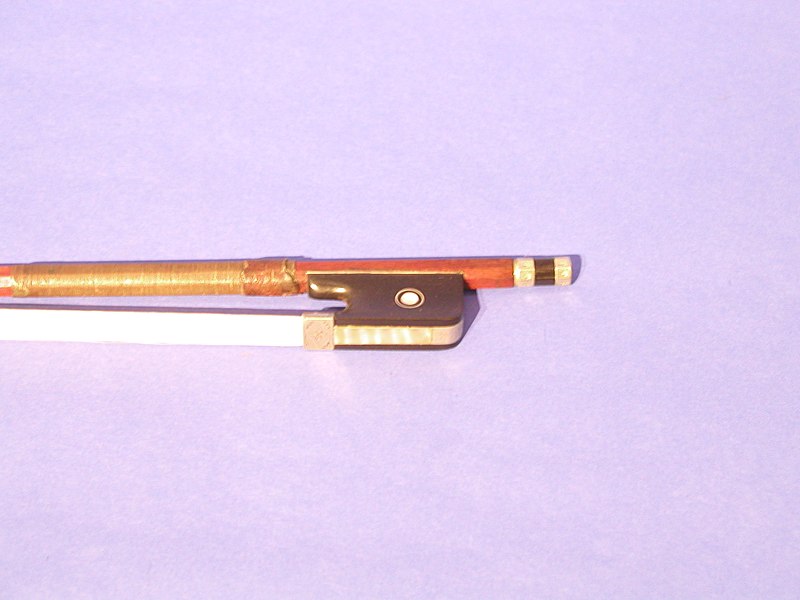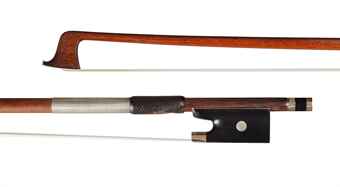Written by Matt Lammers of Fein Violins
It's one of those curiosities that disappeared with age and experience, one of those elephants in the room you asked about as a beginner, and your teacher shrugged it off with a puzzled expression telling you it wasn't worth losing sleep over. It became a part of your vocabulary and was never given a second thought, but in the back of your head you've always wondered: "Why on earth do we call this the frog?" Here at Fein Violins we embrace and resurrect our own childish curiosity and hope to relax the furled brows of confused, [used-to-be] young musicians everywhere.




Carl Grimm worked in the Knopf family shop and was one of many German bowmakers who continued using the Tourte design after working there
English bowmaker John Dodd worked with German violinist Wilhelm Cramer to fashion a bow design somewhat similar to that developed by Tourte. His final product assimilated features from both designs. See our blog about English bowmakers.
Thomas Tubbs, another early English bowmaker after Dodd, attempted to revolutionize bow construction, but would eventually settle into the Tourte design. His innovations, like at-home rehair clips and collapsible bows, proved infeasible
A bow by Nikolai Kittel, a great German-Russian bowmaker that worked using the Tourte design. His bows can be worth more than Tourtes
It's one of those curiosities that disappeared with age and experience, one of those elephants in the room you asked about as a beginner, and your teacher shrugged it off with a puzzled expression telling you it wasn't worth losing sleep over. It became a part of your vocabulary and was never given a second thought, but in the back of your head you've always wondered: "Why on earth do we call this the frog?" Here at Fein Violins we embrace and resurrect our own childish curiosity and hope to relax the furled brows of confused, [used-to-be] young musicians everywhere.
The frog of a bow is a simple, yet intricate thing
The origins of modern bow design are important to understand before we get into the particulars of terminology. The evolution of the Baroque bow to the modern French bow (what the vast majority of string players now use) was facilitated by French bowmaker Francois Tourte. His bows are widely regarded as some of the finest ever made. Virtuoso violinist Jean-Baptiste Viotti came to an unknown Tourte following his lukewarm Parisian debut, which received criticisms accusing his playing of sounding "occasionally rough and abrupt". Viotti attributed this shabbiness to limitations imposed upon his playing by the Baroque bow, a standard tool of the times.


The Baroque bow
The modern French style bow
Viotti and Tourte attributed many of the Baroque bow's limitations to the bow's curvature. Baroque bows, which have a convex stick, allow less pressure and less flexibility regarding the direction the bow can successfully grip the string. This produces less of a sound variety and limits volume and articulation compared to Tourte's bow, which employed a concave stick. To further enhance the maneuverability of a concave stick, Tourte lightened and strengthened the tip of the bow. So the hair wouldn't be angled relative to the stick, he had to raise the heel (general term for the lower half of the bow, which includes the frog) height as well. The wood Tourte found most suitable for his new stick design was Pernambuco. Viotti gave his second performance in Paris not long after the completion of Tourte's new prototype in 1783, and the reviews revealed the effectiveness of their collaboration: "The notes were attacked with better precision and security, and his manner was smoother and more consistent." From this point forward, Tourte's construction was used as a model by bowmakers throughout France and the rest of Europe.
Jean-Baptiste Viotti
The frog of a Hill & Sons bow
Josh Bell couples his Stradivarious with a Tourte bow
An early Tourte bow
A Tourte bow of his early modern style
A late Tourte bow, of his modern style. Note that frog heights vary somewhat
And now, the "frog". There are two reasonable theories we've been able to dig up that explain why we use amphibious ebony on our bows. The first is a clever bit of wordplay. The small vice used by bowmakers to fashion the frog is known as the frock. This term was likely carried over to the finished product, as the frock and heel of the bow have a similar use: to grip the bow. Thus the heel of the bow became known as the frock, and the term was gradually modified through misunderstood word of mouth. Frock, being a vernacular term, likely went undocumented in official usage, leaving no reason to believe frog was incorrect.
A frog in a frock
An alternative is that the grip of the bow, before it was termed frog, was known (and still is known) as the heel. The soft portion of a horses hoof is known as the frog, particularly by the English. Therefore the heel of the bow was named after the "heels" of horses.
Browse the rest of our blog for answers to similar questions, like why we have scrolls and how f holes work.
The fleshy rearward portion of the horse's hoof is known as the frog. Bowmakers would've interacted with farriers (horse caretakers) regularly to swap terminology and purchase horse hair for bows
Perlman plays Viotti's 22nd Violin Concerto. Luthier's consultant, violinist, and composer, Viotti was a jack of all trades
The "eye" of the frog can come in many shapes, sizes, and materials. It adds visual interest to the bow
Frogs have been made from a number of materials, including tortoise shell (shown here)
The frog can be made from ivory as well. The shape of the frog can vary, as long as its height and weight keep the bow balanced
You can even have a solid gold frog in the shape of an eagle if that suits your fancy. I can't imagine it's very comfortable, but I bet it looks good sitting out

The bottom of the bow is typically inlaid with mother of pearl, though other materials are sometimes used. This, like the eye, is for visual impact
Ronald and Zillah Castle collection of Musical Instruments, Wellington, 1998, collection of the Auckland War Memorial Museum
A bow by Wilhelm Christian Knopf (1828), which demonstrates the French influence on German bowmaking; Knopf modeled his frog and dimensions on the Tourte design
image from The National Music Museum
Carl Grimm worked in the Knopf family shop and was one of many German bowmakers who continued using the Tourte design after working there
English bowmaker John Dodd worked with German violinist Wilhelm Cramer to fashion a bow design somewhat similar to that developed by Tourte. His final product assimilated features from both designs. See our blog about English bowmakers.
Thomas Tubbs, another early English bowmaker after Dodd, attempted to revolutionize bow construction, but would eventually settle into the Tourte design. His innovations, like at-home rehair clips and collapsible bows, proved infeasible
A bow by Nikolai Kittel, a great German-Russian bowmaker that worked using the Tourte design. His bows can be worth more than Tourtes
A diagram of the inside of the frog. This includes the mechanism that allows the hair to be loosened and tightened
A disassembled heel, with screw, frog, and stick separated. Please don't do this at home, kids
Are you a violinist or interested in becoming one? Take a look at our Fine Violins!














A friend sent me this link, after talking with a budding bowmaker last night. What a treasure trove this page. Thank you for all the info and the beautiful pictures, as well as the lovely music!!!
ReplyDeleteThe proper name for what you refer to as a 'frog', among English bow making since the days of Dodd, is 'nut'. The French equivalent is 'hausse' which translates as ‘rise’. The purpose of the nut is to make a space between the hair and the stick so the stick can have a significant amount of inward curve and yet the hair doesn’t contact it – the hair rises off the stick.
ReplyDeleteIn Germany there was a word for a riser block used in an engineering workshop similarly to separate items (or to move them closer together) – that word was ‘frosch’. It has now dropped out of use but the term stuck for the violin bow part, translated as ‘frog’ and that bizarre usage went into German trade catalogues and soon became adopted as the universal word for the item. There is also the name for the block attached to the bed of a woodworking plane that changes the angle of the blade and lifts it away from the bed – it’s also called a frog. Nobody else seems to have made that connection, so sadly, it isn’t about the creature at all.
Andrew, U.K.